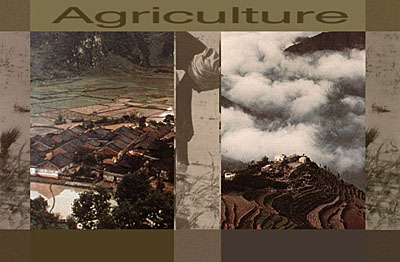While they are not exciting in appearance, settled agricultural villages like this early example at Ban Po, China (below left), represented a radically new way of life for human beings, unlike anything that had existed before.
 First, agriculture means sedentism--living permanently in one place. This was itself new to human beings, and it may have seemed very constraining to the first people to experience this way of life. Living in one spot permanently means exploiting a relatively small amount of land very intensively (rather than exploiting a large amount of land extensively, as hunter-gatherers did), and over a long period of time.
First, agriculture means sedentism--living permanently in one place. This was itself new to human beings, and it may have seemed very constraining to the first people to experience this way of life. Living in one spot permanently means exploiting a relatively small amount of land very intensively (rather than exploiting a large amount of land extensively, as hunter-gatherers did), and over a long period of time.
To understand how radical this change was, it is necessary to consider carefully both the advantages and disadvantages of gaining one's living from one piece of ground and the effects of such a way of life on the environment.


 First, agriculture means sedentism--living permanently in one place. This was itself new to human beings, and it may have seemed very constraining to the first people to experience this way of life. Living in one spot permanently means exploiting a relatively small amount of land very intensively (rather than exploiting a large amount of land extensively, as hunter-gatherers did), and over a long period of time.
First, agriculture means sedentism--living permanently in one place. This was itself new to human beings, and it may have seemed very constraining to the first people to experience this way of life. Living in one spot permanently means exploiting a relatively small amount of land very intensively (rather than exploiting a large amount of land extensively, as hunter-gatherers did), and over a long period of time.